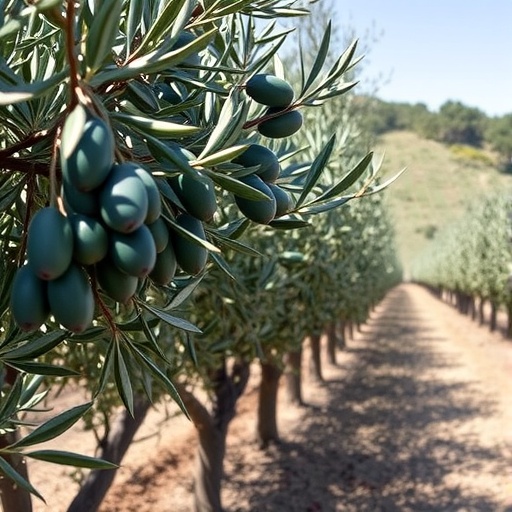In the fertile heart of California’s Central Valley, a quiet revolution is underway in the realm of olive cultivation. Rows upon rows of super-high-density olive orchards, characterized by trees planted in close proximity for rapid, mechanized harvesting, are defying conventional agronomic expectations. A groundbreaking study emerging from the University of California, Davis, has revealed that these intensely packed olive trees can flourish and yield high-quality oil even when subjected to significantly reduced nitrogen fertilization—ranging from 25% to 50% less than the amounts typically recommended for traditional olive orchards.
This two-year experimental investigation, conducted in collaboration with local growers in Woodland and near Stockton, deployed meticulously controlled applications of nitrogen fertilizer alongside organic compost derived from yard trimmings and food scraps. The research, recently published in the journal Agronomy for Sustainable Development, sought to delicately balance nutrient input against tree performance metrics, including vegetative growth, fruit yield, and olive oil quality parameters. The results unequivocally demonstrated that reducing synthetic nitrogen inputs did not compromise the quantity or quality of the olives produced, challenging established fertilization paradigms entrenched within the industry.
At the helm of this revolution is Andrew Curtright, a postdoctoral scholar at UC Davis’s Department of Land, Air and Water Resources, who emphasizes the broader implications of their findings. “Our data highlight an opportunity for California’s olive industry to achieve greater sustainability,” Curtright notes. By leveraging the region’s fertile soils and tailored nutrient management practices, growers can mitigate environmental impacts associated with excessive fertilizer use, without sacrificing crop productivity or the coveted characteristics of premium olive oil.
Integral to these outcomes was the strategic incorporation of compost into the soil management regime. The organic amendments enhanced the bioavailability of nitrogen, particularly during the first year of application, facilitating more efficient nutrient uptake by the olive trees. Beyond immediate nutritional benefits, compost additions contributed positively to soil structure, porosity, and microbial activity, fostering an environment that curtails nutrient leaching and runoff—a critical consideration in the context of sustainable agriculture and groundwater protection.
Moreover, the research incorporated sophisticated isotopic tracing techniques, enabling the team to pinpoint the provenance of nitrogen within the olive tree biomass. Remarkably, only approximately two-thirds of the nitrogen within leaves, fruit, and stems could be traced back to applied fertilizer. The remaining nitrogen was derived from inherent soil reservoirs and endogenous nutrient stores accrued in preceding years. This insight underscores the pivotal role of soil nutrient cycles and organic matter reserves in sustaining perennial crop systems, and signals the potential for further optimization of fertilizer regimes.
The dynamics unveiled by Curtright and colleagues challenge prevailing assumptions about nitrogen dependency in super-high-density orchards and open new avenues for research. Understanding the mechanisms by which soil ecosystems contribute bioavailable nitrogen could inform practices that maintain or enhance soil fertility over the long term, reducing reliance on synthetic inputs. Such knowledge is particularly pertinent to perennial systems like olives, where nutrient cycling and storage are complex and temporally extended processes.
Looking ahead, this pioneering work sets the stage for exploring cultivar-specific responses to varied nutrient management strategies. Different olive varieties may exhibit distinct nitrogen requirements or efficiencies, especially within high-density plantings where root competition and microclimatic conditions diverge from traditional systems. Tailoring fertilization protocols to cultivar traits could further amplify sustainability gains and economic returns for growers.
This project was a collaborative endeavor, involving Savannah Haas from UC Davis and Xia Zhu-Barker, affiliated during the study with UC Davis and currently at the University of Wisconsin-Madison. The research was funded through a grant from the California Department of Food and Agriculture Specialty Crop Block Grant program, which is supported by the U.S. Department of Agriculture. The study’s authors carefully declare no competing interests, positioning this research as an independent contribution to sustainable agriculture science.
The environmental implications of this research are profound, especially in an era where agriculture faces mounting pressures to reduce greenhouse gas emissions and minimize nutrient pollution. By cutting nitrogen fertilizer use without yield penalties, olive producers can contribute to climate change mitigation efforts, lower production costs, and protect vital ecosystem services such as soil and water quality. Furthermore, the integration of organic amendments like compost embodies a circular economy approach, valorizing waste streams from urban and agricultural sources.
Industry stakeholders and policymakers should take note of these findings as they contemplate regulations and incentives aimed at promoting sustainable crop management. The study provides a science-based blueprint for transitioning olive production towards agroecological models that harmonize productivity with environmental stewardship. Mechanized harvesting in super-high-density orchards combined with precision fertilization offers a template for modern, sustainable horticulture in Mediterranean-climate regions worldwide.
In conclusion, the UC Davis-led study disrupts traditional fertilization dogma by proving that less can be more in olive orchard management. Reduced synthetic nitrogen inputs, enhanced by strategic compost application, sustain both the quantity and quality of olive yields in super-high-density plantings, yielding compelling environmental and economic benefits. This research highlights the critical importance of understanding soil-plant nutrient interactions and leveraging organic amendments to optimize fertilization practices for perennial tree crops. As California’s olive industry strives for resilience and sustainability, these insights illuminate a promising path forward.
Subject of Research: The study focuses on sustainable nutrient management in super-high-density olive orchards, specifically examining the effects of reduced synthetic nitrogen fertilization and compost application on tree growth, yield, and oil quality.
Article Title: Compost application and reduced synthetic nitrogen fertilization promote sustainable olive production in super-high-density orchards
News Publication Date: 19-Sep-2025
Web References:
Agronomy for Sustainable Development Article
DOI: 10.1007/s13593-025-01050-1
Image Credits: Savannah Haas/UC Davis
Keywords: sustainable agriculture, olive orchards, nitrogen fertilization, compost application, super-high-density planting, nutrient management, soil health, olive oil quality, greenhouse gas emissions, agroecology
Tags: agronomic research studiesCalifornia olive farmingenvironmentally friendly farming practiceshigh-density olive orchardsmechanized harvesting techniquesnutrient management in orchardsolive oil quality improvementolive tree yield optimizationorganic compost applicationsreduced nitrogen fertilizer usesustainable olive cultivationUC Davis agricultural innovations





